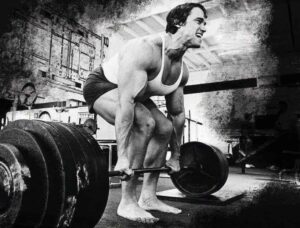One of our favorite movements is the deadlift.
Deadlifts of just about any kind – conventional, KB, trap bar, sumo , single leg, etc.
We love ‘em!
Most of the time when we talk about deadlifts and tips for them, we talk about dialing in standard technical aspects:
-
Keeping the implement as close to you as possible
-
Maintaining your back angle off the floor
-
Having a good amount of lat contraction and shoulders depressed
-
Thinking to “push” the ground to start instead of “pull” the weight
These sorts of things are our go to as while we would consider them “basic” they are the things that matter most, and the most commonly ignored/neglected.
After basic technical components are achieved, we can start getting into fancier stuff. One of those fancier things is footwear.
Does your footwear matter while deadlifting?
A deadlift is an exercise where we focus on standing up erect while bringing the bar with us to our upright position. Our shoes impact that in 3 ways:
-
Shoes with more cushion will lose force that could be directed into the ground.
-
Shoes with a heel lift encourage your weight to go forwards (which we don’t want)
-
Shoes with increased thickness require the bar to travel further from the ground.
Now if you’re someone who isn’t worried about having a bigger deadlift, no worries, keep doing what you’re doing.
In contrast, if you’re someone who is looking to get everything you can out of the lift, this small change can have a pretty big impact for a lot of people.
You’ll see tons of people deadlifting in commercial gyms in runners, but you’d never see that in a powerlifting gym where people are attempting to maximize their lift. Depending on your budget a few different options arise for different footwear with deadlifts.
1. No shoes
Our first option is actually the least expensive and one that is probably most convenient.
Just simply take your shoes off! By ditching the shoes you get rid of all of the negative factors we mentioned previously and don’t need to carry around an extra pair of shoes.
We would generally recommend keeping your socks on for safety and health purposes. If you train at a gym that doesn’t allow this, then one of our next options should help you.
2. Converse
Spend some time around powerlifters and you’ll probably see converse.
These classic basketball shoes became very popular for powerlifting given their non-existent heel lift, low profile, and stiff base.
For most people, these are a great option – plus they’re currently cool shoes.
3. Deadlift shoes
One thing that is a downside to converse is their stability and structural integrity – particularly for rotational and frontal plane forces. Some athletes complain about blowing out their converse and having their foot literally rip through them.
Similarly, some athletes with a history of ankle issues state they feel they don’t get enough support from them. Here comes in the deadlift shoe.
It looks very similar to a wrestling boot but is designed specifically for deadlifting. While there are a few great advantages with them, there is a major negative – the cost.
These shoes can run quite high and if you don’t need those factors listed, there are lots of options.
4. Deadlift slippers
Our final option is the deadlift slipper. For those people who are interested in barefoot/no shoe lifting but their gym doesn’t allow it – this accomplishes that.
Designed to allow people to deadlift in competitions where shoes are required, but without actually wearing a legitimate shoe. Relatively inexpensive, relatively simple, and quite sturdy.
Those four options should cover the vast majority of people.
If you’re wanting to gain every edge on the deadlift you can, footwear can be a beneficial consideration!
The Citizen Athletics Team,
Sam


